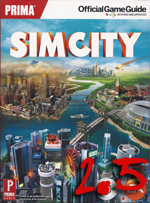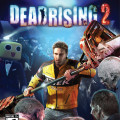 Those who are familiar with the most recent entry in Maxis’ storied SimCity franchise are probably just as familiar with its catastrophically terrible launch. Honestly, the only way you couldn’t know about the controversy was if you didn’t have an internet connection. But then again, you wouldn’t be playing SimCity either, right? Regardless of the politics of the matter, at the core of the conflict sits a game that is extremely complex and entirely redesigned from the ground, up. So what could better compliment the reboot of the brand than a SimCity strategy guide? Let’s just hope that the book fares better than its subject matter at culling the rage of PC gaming curmudgeons.
Those who are familiar with the most recent entry in Maxis’ storied SimCity franchise are probably just as familiar with its catastrophically terrible launch. Honestly, the only way you couldn’t know about the controversy was if you didn’t have an internet connection. But then again, you wouldn’t be playing SimCity either, right? Regardless of the politics of the matter, at the core of the conflict sits a game that is extremely complex and entirely redesigned from the ground, up. So what could better compliment the reboot of the brand than a SimCity strategy guide? Let’s just hope that the book fares better than its subject matter at culling the rage of PC gaming curmudgeons.
Sometimes it is hard to tread the thin line between being a strategy guide and a glorified manual that the player has to pay for in a bookstore. In many respects, the SimCity strategy guide tends to have a bit of multiple personality disorder that precariously teeters in between the two very opposite ends of the spectrum. More often than not, item descriptions and specific details about elements in the world are torn word-for-word from the game itself. This might be somewhat unavoidable given the style of game it is trying to inform the reader about, but for Pete’s sake, the author should have made at least some attempt to pen original content. However, there are also whole dedicated strategy sections at the head of every city element sub-category such as roads, utilities, zoning, city services, mass transit, etc. Does the yin and yang manage to balance itself out? Probably not. But honestly, it would be hard to suggest solid play strategies to the player, without sounding a bit like a text box written by the game’s developers.
Actually, the developer Maxis’ aid in the creation of this book is very evident, both from a content perspective, as well as in the special features. For one, almost the entire introduction to the game and mechanics walkthroughs were penned by folks who actually designed the game’s core systems and interactions. Also, while it does seem like there is quite a bit of repeated information from within the title’s tool tips, at the end of each city element’s section there is a call-out featuring another member of the development team. In these areas the developer discusses pertinent hints, as well as topics about the items/landmarks being broken down in that specific part of the text. This was a nice touch that somewhat personalizes what could otherwise be viewed as semi-redundant data.
All of that said, there is a fair amount of explanation in each of these areas, talking about why certain landmarks are important to construct and how they can influence the rest of the city’s fragile ecosystem. It is far from the end-all, be-all, but it definitely provides a good jumping off point for those who are not familiar with how cohesively the entire city interacts with itself. The problem is that these extra detailed sections tend to be rather intermittent, depending upon what the writer deemed to be the most critical. There are far too many cases where whole chucks or page are left with vacant white space, accompanied by a literal copy and paste of text descriptions and statistical information straight from within the game itself.
Scattered throughout the text are the usual “Tip” sections that can be found in most current game guides. Though they might not always provide the most practical information, there usually tends to be some nugget embedded within that will tend to be very useful to even power players. Things like knowing to place different forms of mass transit within two hundred steps of each other, because the Sims are not willing to walk any further to make transfers are great clues that may not reach out and smack the player, but could drastically play a role in how one were to lay out a city. While not all suggestions are quite as useful as something like that, (and heck, it may even been something that is brought to the attention of the player by the game itself over time) getting the jump on this kind of information can help build a more thoughtful and appealing cityscape.
Another important section to pay special attention to is the “Disasters” portion of the guide. It may not be overly large, but anyone who has ever played a SimCity title knows how crippling these events can be, if not handled properly. This area outlines both what to expect when one of these disasters occur as well as what can be done to either brace/prevent the least amount of impact or how to recover in the aftermath. Achievement whores also take note, because all of the possible achievements that can be earned from surviving any particular onslaught are listed at the end of this section. Actually this holds true for pretty much every key section in the book, as well as listed in the “quick reference” at the end of the tome.
There are two main drawbacks from using a guide that is this closely tied to the developer. For one, most of the text about specific game elements tends to be borrowed from the source code, which has been mentioned ad nauseam earlier on. Secondly, with all of the sections written by members of the Maxis team, it is hard to distinguish between what is legitimately helpful information and what is PR-filtered fluff, that provides very little benefit for the lay user. With both of those criticisms in mind, what probably stands out the most is that this is a guide that is very much targeted at new SimCity players. Those that have had experience with prior iterations in the series will be able to learn about some of the newer nuances, but in most circumstances the text is regurgitating common sense.
One last unsettling note about the book is that at the beginning of every new section, there is a call-out in the bottom left corner of the page, reminding the reader to redeem their code for the digital guide. Thankfully this is included at no extra cost, with the purchase of the print guide. Given the nature of SimCity being an online-required game, it stands to reason that anything printed on the parchment could be rendered useless by a single update. Reasons like this tend to play more into the hand of electronic guides, and even though Prima already has one, why wasn’t this strategy guide electronic-only to begin with? At the end of the day it would seem that it would be the more logical and economical approach for all parties involved.
Prima’s official SimCity strategy guide manages to be competent enough to benefit the reader, yet not impressive enough to truly warrant a recommendation. Simply put, there are millions sites on the internet that provide far more up-to-date analysis and guidance, without the burden of a making space on your bookshelf for a mediocre work that often reads more like a curated press release than useful guidance. As is the case with most online centric games, readers may be better served turning to the forums.
SGR Rating: 2.5/5
Author: David Knight and Dorothy Bradshaw
Publisher: Prima Games
Editions available: Paperback and Kindle Edition
Acquired via Publisher




Leave a Reply